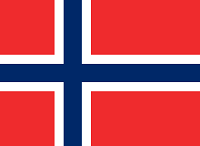Regulation Relegation
As they say, “if the power to tax is the power to destroy, the power to regulate is no less so.” Those are the words of Markham Shaw Pyle, a Texan historian, and for the sake of Norway's Brewing history, truer words have never been spoken. But first, let's establish the scene. Norway, is a Scandinavian country with a King (Harald V), Prime Minister (Erna Solberg), and a unitary parliament. Though it has more land than Montana, its population of only 5,140,000 makes it the second least densely populated country in Europe. It's famous for very little outside of being very cold, wealthy, mostly socialist, full of natural resources, and being the host country for two Winter Olympic Games. Beer, as it turns out, is specifically left out of this short list of things, because of the government laid out before. Though Norway has highest Human Development Index and the 3rd highest nominal GDP per capita in the world, their economic policy is more socially defined than you'd think. There is a substantial amount of private industry expanding in the highly taxed country, but the government controls a vast amount of important resources and vital sectors, including energy exploration, production, and distribution (exportation), which accounts for 25% of the nation's GDP, the largest portion of Norway's exports, and 20% of the government's revenue. The economic landscape also employs an impressive public safety net in the form of The Nordic Model, superficially characterized by a highly sophisticated social welfare program, universal healthcare, public pensions, subsidized higher education, high tax rates, and high public spending. This also means that the government has had much more leverage in regulating other "privately owned" business sectors, especially when it comes to alcohol.Norway has a long and storied history with brewing, but sadly, government intervention has nearly relegated the industry to a mere shadow of what it once was. For centuries, it was customary for each and every Norwegian farm to have its own Bryggehus, or brew house. The people were very proud of their craft brewing heritage, as homebrewing was a common practice. There were a very large amount of different native and foreign rooted beer styles being crafted in Norway until the early 20th century, when home brewing was made illegal and the entire brewing industry became heavily regulated and taxed. Private companies still operate within Norway, but because of the increased level of regulation, most of the largest brands have been consolidated into two multinationals: Carlsberg-Ringnes, and Hansa Borg Bryggerier, Norway's largest Norwegian owned brewery, and second largest overall. Carlsberg-Ringnes is the result of a acquisition of the Pripps Ringnes brewery (at the time, Norway's largest native brewery) completed in 2004. It was the first time a major brewery in Norway was owned by a foreign organization, and viewed as a national tragedy. Since homebrewing was made illegal, the interest in brewing a large amount of varieties decreased, and Pilsners are the most "popular" style, representing a total 92% of the domestic market. Beer containing more than 4.75% ABV must be sold in government owned liquor stores, which has lead some import brands to decrease their alcohol content in mainstream brands specifically for sale in the Norwegian market. In this way, brewers had access to Norway's supermarkets and other retail outlets. Norway's pubs, bars, and nightclubs have a long standing tradition of contracting only one brewery for each venue, resulting in a rather limited number of taps per location. Beer (along with any other alcoholic beverage) is taxed according to its ABV, with four defining classes (A-D), A being virtually alcohol free, to D being beers containing more than 4.75% ABV, being taxed a minimum rate plus an additional rate per .1% above 4.75%, and only being sold in government run stores (Vinmonopolet). Norway also has very strict operating motor vehicle laws, which forbid drivers to drive virtually on the same night as they drink. The legal limit is .01 BAC. Norway is also one of the only countries in Europe with strict enforcement on a 18+ drinking age.
Despite of all of this malarkey, Norway is still 34th in the world in terms of beer consumption per capita, tied with its neighbor, Sweden. Though a very new concept in the country, Microbreweries are beginning to sprout up around the country in sparse numbers, and some traditional styles are being brought back into mainstream production. So despite a rather bleak recent history, Norway still has a robust heritage of brewing spanning more than a thousand years, and hopefully with this new growing interest in microbreweries and craft brewing, the story will continue for at least a thousand more.
Skal.
Rated Norwegian Beers
6-10-17 - Ringnes Bryggeri Pilsener - 2.79, Norwegian Pilsner, 4.50%
6-09-17 - Små Vesen Kvernknurr ESB - 3.08, Norwegian Extra Special/Strong Bitter, 6.50%
6-07-17 - 7 Fjell Eiffeltarnet - 3.22, Norwegian Stout, 7.50%
6-07-17 - Nogne Ø IPA - 3.29, Norwegian IPA, 7.50%
6-06-17 - Austmann IPA - 3.14, Norwegian IPA, 6.50%
6-06-17 - 7 Fjell Silt An - 3.17, Norwegian Saison/Farmhouse Ale, 6.50%
6-04-17 - Kinn Bryggeri Strandgata Bitter - 3.36, Norwegian Extra Special/Strong Bitter, 4.20%
6-04-17 - Hansa Lager - 2.74, Norwegian Pilsner, 4.70%
6-04-17 - Lervig Tasty Juice - 3.48, Norwegian IPA, 6.00%
6-03-17 - Northern & Co High Tide Rye Stout - 3.29, Norwegian Stout, 7.00%
6-03-17 - Qvart Olkompani Juicy Lucy - 3.23, India Pale Ale, 6.00%
6-03-17 - E.C. Dahls Bolt IPA - Bolt IPA, 2.67, Norwegian IPA, 6.90%
6-03-17 - Little Brother The Saga Continues - 3.09, New England IPA, 6.40%
6-03-17 - Amundsen Everyday Hero - 3.51, Norwegian IPA, 4.70%
6-03-17 - Amundsen Ink And Dagger - 3.79, Norwegian IPA, 6.50%
6-03-17 - Oslo Brewing Dream Porter - 3.03, Norwegian Porter, 6.50%
6-03-17 - Little Brother Hop Into Darkness - 3.19, Norwegian Black IPA, 4.70%
6-03-17 - Oslo Mikrobryggry Raspberry Porter - 3.27, Norwegian Porter, 6.50%
6-03-17 - Cervisiam Satanic Panic - 3.22, Norwegian Double/Imperial Milk Stout, 10.00%
6-03-17 - Grunerlokka Gerijagress - 2.97, Norwegian Double/Imperial IPA, 8.00%
9-18-12 - Nogne Ø Porter - 4.00, Norwegian English Style Porter, 7.00%
 The Beer List -
The Beer List -




